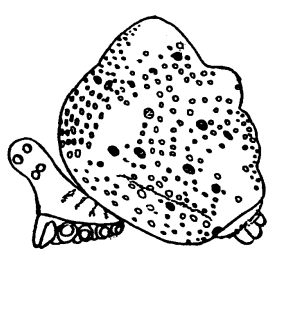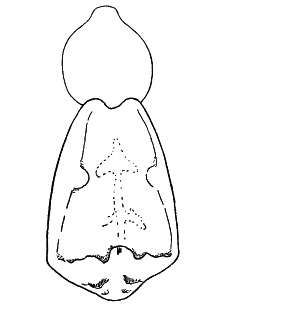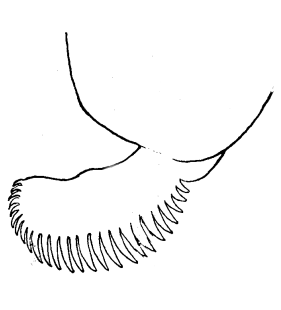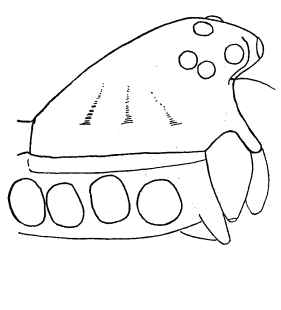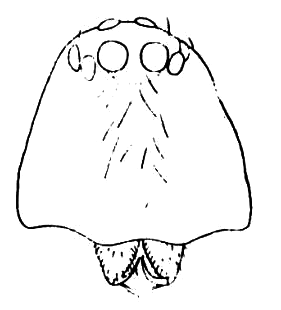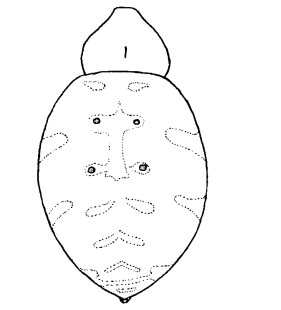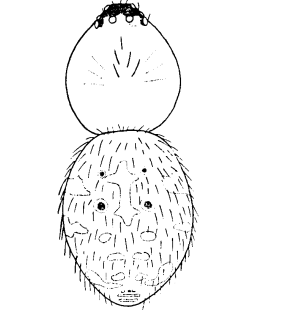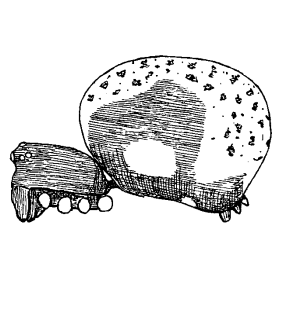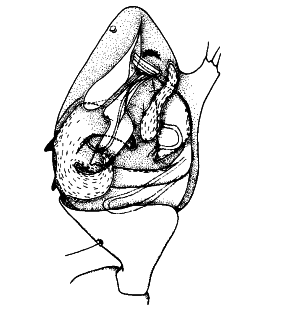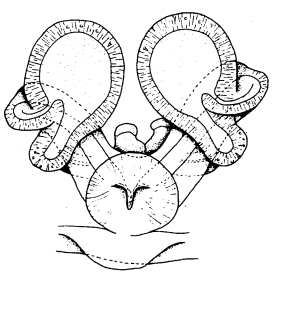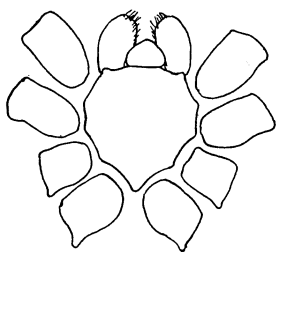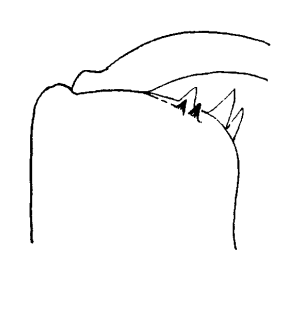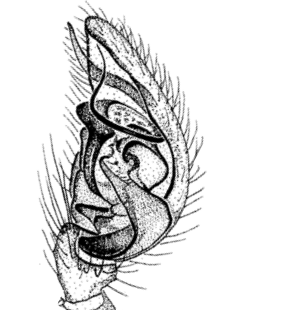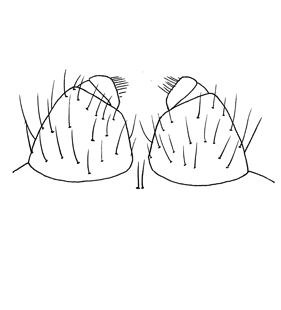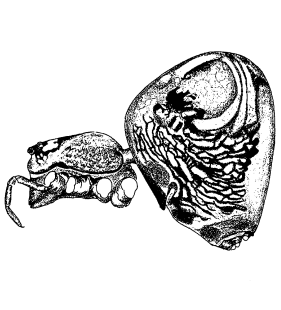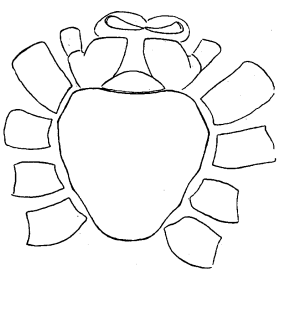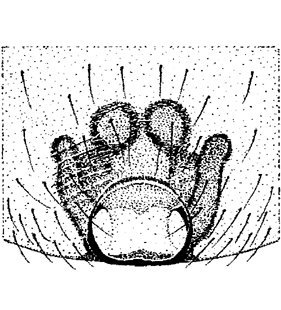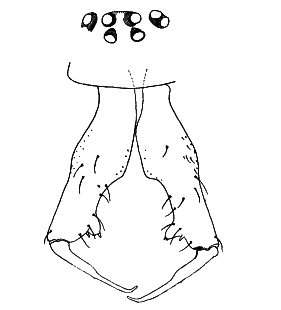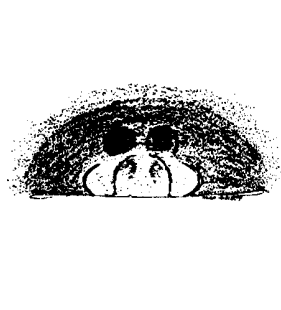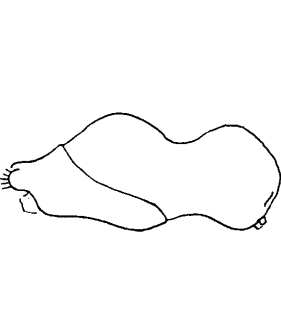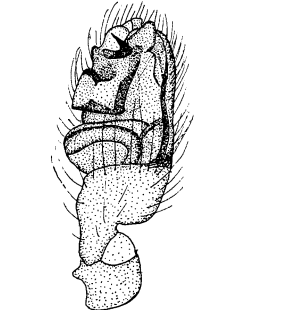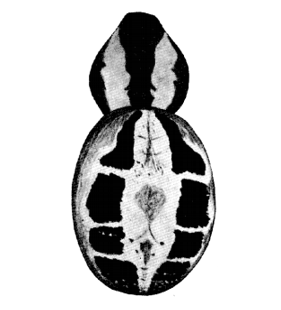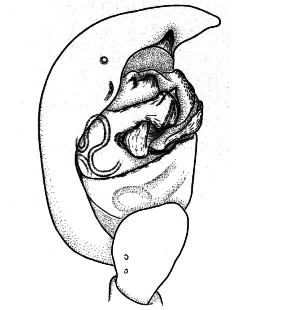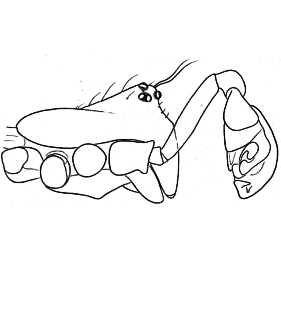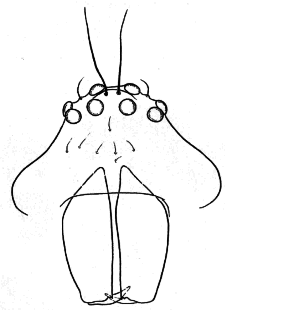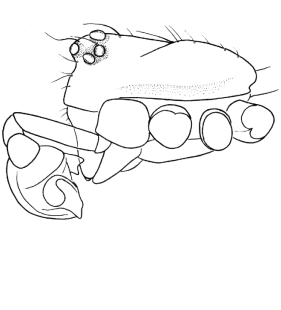Family Theridiidae Sundevall, 1833
|
In case you find an error or have a specific suggestion, please follow this link: click
|
||||||||
| 1 |
Tarsi of leg I swollen |
|||||||
| - | Tarsi all equal and not swollen |
|||||||
| 2 (1) |
Anterior median eyes smaller than other eyes |
|||||||
| - | Anterior median eyes larger, eyes in two rows, males without scutum |
|||||||
| 3 (2) |
Anterior median eyes very small, the other eyes in two groups, male opisthosoma with scutum, body length 1.2 - 1.5 mm |
| ||||||
| - | Anterior median eyes smaller than the other eyes, eyes closely positioned together, semi-circular, opisthosoma without scutum, oval, but slightly longer than wide, males slim |
|||||||
| 4 (2) |
Anterior and posterior lateral eyes separated from each other at least by one diameter |
|||||||
| - | Lateral eyes hardly separated from each other, nearly touching each other |
|||||||
| 5 (4) |
Tarsi longer than metatarsi, small spiders, body length 1-2 mm |
|||||||
| - | Tarsi shorter than metatarsi, body longer than 1.5 mm |
|||||||
| 6 (5) |
Opisthosoma sclerotized, with humps |
| ||||||
| - | Opisthosoma not sclerotized, rounded |
|||||||
| 7 (6) |
Male clypeus with conus-shaped projection, female unknown |
| ||||||
| - | Clypeus not modified |
| ||||||
| 8 (5) |
Male with conspicuous frontal protrusions, opisthosoma conus-like extended, southern Europe |
|||||||
| - | Male without frontal protrusions, opisthosoma different |
|||||||
| 9 (8) |
General colouration light brown, opisthosoma uniformely light brown, without mottling, extruded into a long protrusion |
|||||||
| - | Opisthosoma not extruded into a long protrusion |
|||||||
| 10 (9) |
General colouration dark brown, opisthosoma with bright white shining guanine dots |
|||||||
| - | General colouration uniformely light brown, opisthosoma truncated, ending up with several humps |
|||||||
| 11 (8) |
Opisthosoma in females wider than long, with lateral protrusions, shiny, black and yellow or uniformely black coloured (except Theridula aelleni) |
|||||||
| - | Different |
|||||||
| 12 (11) |
Opisthosoma elongate, clearly longer than wide, triangular, truncated, slim in males |
| ||||||
| - | Opisthosoma spherical or of different shape |
|||||||
| 13 (12) |
Prosoma elevated, chelicerae short, anterior median eyes mostly larger than posterior median eyes, female pedipalp with comb-like claw, females with four receptacula |
| ||||||
| - | Prosoma comparably flat, chelicerae long, anterior median eyes not larger than posterior median eyes, claw of female pedipalp not modified, females with two receptacula |
|||||||
| 14 (13) |
Opisthosoma pointed, spinnerets visible in dorsal view, cheliceral claw long, trichobothrium of metatarsus I at 0.8 - 0.9 |
| ||||||
| - | Opisthosoma rounded, protruding over the spinnerets which therefore are not visible from dorsally, , cheliceral claw mostly short, trichobothrium of metatarsus I at 0.3 - 0.5, only in Dipoena braccata at 0.7 (trichobothrium difficult to detect)
incl. listed genera below |
| ||||||
| - | ||||||||
| - | ||||||||
| - | ||||||||
| - | ||||||||
| 15 (13) |
Colulus clearly protruding or invaginated and replaced by 2 setae |
| ||||||
| - | Colulus lacking |
|||||||
| 16 (15) |
Colulus large and clearly visible, female chelicerae with 0 - 2 teeth at the posterior claw margin |
|||||||
| - | Colulus invaginated, only detectable due to the 2 setae, female chelicerae with 4 teeth at the posterior claw margin |
|||||||
| 17 (16) |
Prosoma rough |
|||||||
| - | Prosoma smooth |
|||||||
| 18 (17) |
Sternum comparably broad and posteriorly truncated, cymbium of the male pedipalpus with a prolateral projection, chelicerae in both sexes similar, body length 2 - 3 mm, colulus clearly visible, covered with 2 setae |
| ||||||
| - | Sternum posteriorly pointed, cymbium not modified, male chelicerae often enlarged, body length of European species 3.5 - 13.0 mm, colulus large, with 6 - 8 setae |
|||||||
| 19 (18) |
Striking body colouration, opisthosoma dark with yellow spots or markings, femora of the males thickened and ventrally with thorns |
|||||||
| - | Body colouration different, femora of the males ventrally not with thorns |
|||||||
| 20 (17) |
Sternum protruding between coxae IV, opisthosoma often with dorsal pattern (except E. thoracica), male chelicerae strongly enlarged, with distinct teeth, female chelicerae with one tooth at the posterior claw margin, receptacula seminis regularly rounded |
| ||||||
| - | Sternum not protruding between coxae IV, opisthosoma uncoloured grey to brown, chelicerae in both sexes similar, chelicerae with 2 teeth at the posterior claw margin, receptacula seminis posteriorly narrowed |
| ||||||
| 21 (16) |
Male pedipalpus with conspicuous bristles, epigyne inconspicuous, without scapus, southern Europe |
| ||||||
| - | Bristles of the male pedipalpus different, epigyne with scapus |
| ||||||
| 22 (15) |
Opisthosoma higher than long |
|||||||
| - | Opisthosoma not higher than long |
|||||||
| 23 (22) |
Opisthosoma with dorsal hump or conical |
|||||||
| - | Opisthosoma without dorsal hump, rounded |
|||||||
| 24 (23) |
Small, body length 1.2 - 1.6 mm, dark colouration, with irregular pattern of bright dots |
|||||||
| - | Larger, body length 1.7 - 4.1 mm |
|||||||
| 25 (24) |
Bright body colouration, opisthosoma conically extended, with white or dark patterns of stripes or conspicuous spiny bristles |
|||||||
| - | Body length 1.7 - 3.2 mm, body colouration bright or dark brown, opisthosoma with inconspicuous hump and with bright motting, introduced to Central Europe, only in greenhouses |
|||||||
| 26 (23) |
Conductor exceeds cymbium clearly, epigynal depression large |
| ||||||
| - | Conductor does not exceed cymbium, epigynal depression and entrance duct small, inconspicuous |
|||||||
| 27 (22) |
Tibiae I-IV with 1/1/1/1 setae |
|||||||
| - | Sequence of setae at tibiae I-IV different, mostly 2/2/1/2 |
|||||||
| 28 (27) |
Trichobothrium at metatarsus III present, position of trichobothrium at metatarsus I-II at 0.9 - 0.95, body colouration bright yellow with black mottling |
|||||||
| - | Trichobothrium at metatarsus III lacking, body colouration mainly red to orange brown, opisthosoma with dorsally serrated folium pattern |
|||||||
| 29 (27) |
Legs, prosoma and opisthosoma with long, protruding bristles, metatarsi dorso-basally with a long bristle, at hind legs longer, male pedipalp large and very prominent, with strongly sclerotized embolus, southern Europe |
|||||||
| - | Bristles of legs and body inconspicuous, metatarsi dorso-basally without long bristle |
|||||||
| 30 (29) |
Sternum posteriorly wide, coxae IV by this widely separated, tibiae I-IV with 2/1/1/1 setae, metatarsus III without trichobothrium, body length 1.2 - 2.0 mm, legs relatively short |
|||||||
| - | Sternum posteriorly pointed, metatarsus III with trichobothrium, body length 2-4 mm, legs longer |
|||||||
| 31 (30) |
General colouration bright yellow to bright brown, sometimes mottled |
| ||||||
| - | General colouration bright red brown, southern Europe |
|||||||
| 32 (30) |
Tibiae I-IV with 2/2/1/1 setae, body length 2.5 - 3.0 mm, general colouration yellow–reddish, opisthosoma dorsally with ample black area, male pedipalpus very voluminous |
|||||||
| - | Tibiae I-IV with 2/2/1/2 setae, body length 2-4 mm |
|||||||
| 33 (32) |
Male chelicerae clearly elongated, tarsal claws smooth or with a few small denticles, egigyne as figure |
| ||||||
| - | Male chelicerae less elongated, tarsal claws with several large lateral teeth, epigyne different |
|||||||
| 34 (33) |
Male opisthosoma constricted, anteriorly with a sclerotized ring , forming two lobes, each with setae, epigyne as figure, introduced to Europe, only in greenhouses |
| ||||||
| - | Different |
|||||||
| 35 (1) |
Ocular area of males slightly elevated when seen in a side view, with short hairs between median eyes, females with conspicuous protruding epigynal depression, northern Europe |
|||||||
| - | Different |
|||||||
| 36 (35) |
Male pedipalpal tibia with slim excrescence, male pedipalp with voluminous subtegulum, tegulum and numerous spermophor loops, cymbium apically with tubercular projection, epigyne as figure, general colouration yellow, males with black spots |
|||||||
| - | Different |
|||||||
| 37 (36) |
Trichobothrium at metatarsi I-II at 0.6 - 0.7, body unicoloured reddish-brown, body length of males 3 - 4 mm, of females 4 - 6 mm; male pedipalp and epigyne as figure, introduced to Europe, only in greenhouses |
| ||||||
| - | Position of the trichobothrium at metatarsus I-II in the basal half |
|||||||
| 38 (37) |
| |||||||
| - | Different |
|||||||
| 39 (38) |
Male clypeus projecting, cheliceral apodemes do not reach anterior median eyes, integument shiny, sparsely pilose, opisthosoma of some species with small dorsal hump, legs long, slender, male epigaster not projecting, femur of the male pedipalpus long (0.7 - 1.1 mm), cymbium large, overtopping the bulbus |
| ||||||
| - | Male clypeus not projecting, cheliceral apodemes nearly reach anterior median eyes, integument faint, pilose, legs relatively short, male epigaster usually projecting, femur of the male pedipalpus short (0.3 - 0.6 mm), cymbium not modified, opisthosoma often with undulated dorsal folium pattern
incl. genera listed below |
| ||||||
| - | ||||||||
| - |
Further genera
- 1. Meotipa
- 2. Thwaitesia
- 3. Tidarren
- 4. Yunohamella


